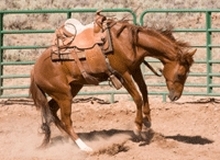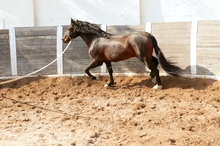I first saw Nan on a large horse farm I managed 13 years ago. The farm kept its herds in large turnouts and the mare and foals band was turned out daily on 35 acres. We brought them in twice a day to feed them and do a visual check-over, but for months at a time the foals were kept out on pasture.

Learning the ways of the horse
Daily turnout helped the foals to develop an open mind, lots of exposure to herd dynamics, plus sound bodies.
It was the operating belief of this farm that daily turnout helped the foals to develop an open mind, lots of exposure to “herd” dynamics (which by the way is VERY important to mental development and affects training aptitude later on), and sound bodies.
Please understand that Nan was my first horse and I had a steep learning curve with her in the first five years of ownership. When Nan and I moved to California in 2004 for a couple of years, the challenges of horse keeping became very evident for me.
Helping your horse meet the challenges of new circumstances
Acreage for turnout was nonexistent for the average horse owner and what was available was minimal and really expensive, far beyond my budget. So off Nan went to a boarding facility, and while I understand the need for boarding barns, as an owner you must make a commitment to an almost daily working of your horse or physical, mental, and emotional issues will develop.
The first thing that happened was Nan got depressed. She went from having free turnout on lots of acreage for many hours a day to a 20 x 24 partially-covered paddock. She got bored, paced in a circle endlessly, and, in the beginning, went off her hay. Then she went to eating her hay nonstop, to the point where I paid for extra hay to be left in her stall.
I made a commitment to go and see her five days a week and get her out and ride her in the arena or the mile or so of trail that existed at this barn. Then the behavior issues started: balking, spooking, and heavy resistance to everything I asked of her.

Horse bucking to let off steam
Without turnout and exercise, horses develop behaviors such as bucking, spooking and resistance to handlers.
My trainer suggested that I buy a trailer and that I start taking her away from the barn experience. I did, and we started to trailer out on the weekends to new places to ride and rode for longer amounts of time. Two things happened, Nan and I got used to going to new places and our confidence in each other to handle it blossomed.
Horse and owner - learning to adapt
I moved back to Texas and Nan went back to living on large acreage with turnout daily on 10 acres and great grass. I got into competitive trail riding, bought a second horse, and life was fabulous for about six years. As life is wont to do, things changed and I now live on an acre with two horses and a super limited turnout area.
I have learned how to keep my pasture picked on a daily basis (who wants to eat grass with poop everywhere and it keeps my pest load way down) and I have had to reschedule myself to keep Nan active in mind and body by using what I have available to me, which is a round pen and the local neighborhood to ride around in (I know l am lucky that way).

Exercising horse in round pen
On limited acreage, a round pen is great for keeping horses active in mind and body.
I trailer out almost one day every weekend to somewhere. I try to make it to at least one competitive trail ride once a month (hard to do with diesel prices, I know). I have also made a friend six miles away who lives in a “horsey” development and they have trails all over the place, so Nan and I are working up to literally walking over there and riding for a couple of hours and coming home every weekend.
Sometimes, experienced trainers know best
What this little story is about is why turnout is so very necessary. My trainer was an old Californio cowboy who was a natural horseman long before it ever became Monty Roberts popular.
Reed left me with several pieces of advice that seven years later I still use ALL of the time. One of them is that people have a tendency to make horse keeping a really complicated thing, and the best method of keeping horses is the KIS method (keep it simple).
Horses are animals that are used to roaming long distances to eat and drink. They need constant fiber intake to keep their bowels happy. They need water to keep them from colic, and MOVEMENT is what keeps all the above going and in harmony.
So it stands to reason that when you take a prey animal who has lived like that for a millennium and “cage” it in a box stall, give it one hour a day of your idea of mandated exercise, no time off or out… well, you are going to have an unhealthy companion, physically, mentally and emotionally.

Enjoy the moment with your horse
Daily turnout, exercise, and attention is the commitment we must make when we decide to make horses a part of our life.
It is no wonder that horse trainers are staying busy, and it is even still more surprising that these absolutely magnificent animals do not make it in the news more often: “Aggressive Horse Kills Owner in Fit of Temper".
I have repeatedly seen situations where a horse literally had every right to give back or mete out punishment and it kept going with as even a temper as possible. Daily turnout, exercise, and attention is the commitment we must make when we decide to make horses a part of our life.
As I finish up here, I am off to ride Nan in the beautiful neighborhood I rent in now and to enjoy the lovely spring weather. Take advantage of what you have available at this moment and enjoy your companion…. Happy Trails.
